Luca Gurrieri1*, Siragusa Emilio1, Marco Andolfi1, Marco Caponnetto1, Stefano Perez1, Giuseppe Mobilia1, Salvatore D’Amato1, Pietro Maniscalco1, Corrado Ciatti1, Calogero Puma Pagliarello1, Fabiana Valenti1, Danilo Zuccalà1, Fabio Sammartino1, Gianluca Puglisi1, Simona Cicciari1, Gianluca Testa1, Vito Pavone1
1Department of General Surgery and Medical Surgical Specialties, Section of Orthopaedics and Traumatology, AOU Policlinico-San Marco, University of Catania, Via Santa Sofia 78, 95100 Catania, Italy
*Corresponding Author: Luca Gurrieri, Department of General Surgery and Medical Surgical Specialties, Section of Orthopaedics and Traumatology, AOU Policlinico-San Marco, University of Catania, Via Santa Sofia 78, 95100 Catania, Italy; Email: [email protected]
Published Date: 07-08-2022
Copyright© 2022 by Gurrieri L, et al. All rights reserved. This is an open access article distributed under the terms of the Creative Commons Attribution License, which permits unrestricted use, distribution, and reproduction in any medium, provided the original author and source are credited.
Abstract
Periprosthetic knee fracture occur most frequently around the distal femur and are frequently complicated due to poor bone quality and comorbidities. Surgical treatment is typically necessary and requires varied techniques of open fixation, intramedullary fixation, or revision arthroplasty, due to fracture classification. The aim of the study is to report the results obtained in the treatment of periprosthetic knee fractures, comparing the results of two surgical techniques, retrograde intramedullary nail and ORIF with plate and screws.
At our institute, a sample of 23 patients with periprosthetic knee fracture were surgically treated.
In detail, our patient cohort consisted of 13 women (56.52%) and 10 men (43.48%) with a mean age of 71.91 years (SD ± 12.05) whose mean follow-up was 19.14 months (SD ± 9.90). In terms of treatment, 7 of 23 patients (30.43%) were treated with retrograde Intramedullary Nail (IMN), 2 patients (8.70%) underwent to revision of the prosthesis and 14 patients (60.87%) were treated with plate and screws (ORIF). The clinical evaluation was performed using two different clinical scores as reference, the Lysholm score and the Sanders score.
The goal of treatment of periprosthetic knee fractures should be an early mobilization of the patient, in order to reduce the risk of prolonged immobilization, limiting surgical risks.
Intramedullary nailing reduces blood loss and provides for shorter surgical times. However, it does not allow an anatomical reduction of the fracture and it is not always possible to achieve, due to the conformation of the prosthetic box. The mean results obtained from the evaluation by Lysholm Score was 58.75 ± 10.46 in group treated with IMN and 63.60 ± 6,82 in the group treated with ORIF. Sanders Functional Evaluation Score was 63.60 ± 6,82 in group treated with IMN and 28.26 ± 6.01 in the groups treated with ORIF. The results obtained are similar to the literature. Student’s t-test showed no statistical significance (p-value >0.05). Fractures healed on average at 4 months. We observed a case of mobilization of the nail. Intramedullary nailing reduces blood loss and provides for shorter surgical times. However, it does not allow an anatomical reduction and it is not always possible to achieve, due to the conformation of the prosthetic box.
The ORIF with plate and screws allows an anatomical reduction of the fracture, but involves in greater risks. It appears, therefore, more suitable in relatively young subjects. The reduction and synthesis with MIPO technique appears a good compromise. However, it is not very effective in comminuted and multi-fragmentary fractures.
Keywords
Periprosthetic Knee Fractures; Retrograde Intramedullary Nailing; MIPO Tecniques; Total Knee Arthroplasty; Plate and Screws
Introduction
Periprosthetic knee fractures represent a problem for surgeons and are difficult to treat due to fracture morphology, bone quality, associated with osteopenia and osteoporosis and the comorbidities of older patients. These fractures are expected to become more common, due the increasing number of TKAs performed.
The Mayo Clinic reported that approximately periprosthetic knee fractures occurred in 2% of cases, of which 0.1% occurred intraoperatively, 0.9% occurred during prosthesis revision. The incidence of these supracondylar fractures according to the most up-to- date epidemiologic data can be placed in the range of 0.2-1.8% after TKA and between 1.6-38% following or concurrent with prosthesis revision [1,2].
Periprosthetic tibia fractures, on the other hand, are less frequent; a series of 17,000 TKA cases showed an incidence of 0.1% of tibia FPP intraoperatively and 0.4% postoperatively [3].
The incidence of periprosthetic patellar fractures after TKA shows an incidence of 0.68% of which 44% are asymptomatic or poorly symptomatic [4].
Statistically, there is a greater tendency for these fractures to occur between 2 and 4 years after prosthesis, generally after low-energy trauma caused by torsional and compressive forces [5].
Meticulous surgical technique is essential to prevent the occurrence of intraoperative FPPs.
Between 40 and 52% of reported femur fractures are related to the presence of anterior notch [6].
The most widely used classification for periprosthetic knee fractures remains Rorabeck classification [7]. It classifies according to dislocation of bone fragments and stability of components but not considering bone reserve (Fig. 1).

Figure 1: Rorabeck classification of periprosthetic knee fracture: Type I: Undisplaced fracture, prosthesis stable. Type II: Displaced fracture, prosthesis stable. Type III: Unstable prosthesis with or without fracture displacement.
In the case of periprosthetic knee fractures, the aim is to promote healing and recover joint function as quickly as possible, in order to prevent the complications of prolonged immobilization.
Alignments with a degree of translation of less than 5 mm, angulation of less than 5-10°, rotation less than 10° by defect and with a level of femoral shortening less than 1 cm are accepted [8].
Surgical treatments include the use of intramedullary retrograde nails, plates and screws and revision prostheses [9].
Prosthesis revision may be an option, but it is highly invasive and involves major bone loss. For this reason, it is reserved for type 3 fractures, in which there is prosthesis mobilization (Fig. 2).

Figure 2: PPF flowchart.
Fixation with Plate and Screws
Open reduction and internal fixation with plate and screws is the most used technique, allow the surgeon anatomical reduction.
A study of Hassan, et al., inherent 26 patients treated with plate and screws concluded that the use of plate and screws allowed a union rate of 96% and that complete healing at six months after surgery was possible in 93% of cases [10].
The use of “Mini open” surgery (MIPO Tecnique) and the sliding LISS plate is the preferred technique to preserve soft tissues, with reduced infectious risk due to the small size of the surgical wound than open surgery, however it requires an experienced team and it is more difficult to perform in complex fractures (Fig. 3).

Figure 3: Fixation plate.
Retrograde Intramedullary Nail
The use of retrograde intramedullary nail turns out to be a viable alternative to osteosynthesis with plate and screws. Anterograde nailing is efficacious for the treatment of subtrochanteric and femoral diaphyseal fractures. Retrograde nailing has been shown to be equally effective in the treatment of fractures of the femoral shaft and very advantageous for distal one-third and supracondylar fractures, in which, the anterograde nail presents for the surgeon considerable difficulties in reducing. In fact, the retrograde nailing allows a better control of the rotation and reduction of the distal fragment [11,12]. However, in the literature, opinions are discordant [13].
The advantages of nailing are:
- The lower surgical exposure
- Reduced of blood loss
- Preserving periosteal blood supply
- Intervention of shorter duration
- It does not require exposure of the fracture
Retrograde nailing of supracondylar fractures should involve the use of locking nails with at least two distal and one proximal screw; the nail should be long enough to reach the small trochanter of the femur in order to bypass the isthmus and prevent the “wiper” effect, increasing the stability of the synthesis.
The limitations of this type of surgery are:
- Temporary inhibition of erythropoiesis for 48-72 h after surgery [14]
- Impossibility to pass the nail through the prosthesis box
- Impossibility to anatomically reduce the fracture
Therefore, the use of this technique is limited to very elderly patients, with numerous comorbidities and low life expectancy and cannot be used in multifragmentary fractures [15].
Several types of prostheses, particularly those with cruciate retention, pose risks in inserting the nail posterior to the Blumensaat line, predisposing to deformity in curvature and misalignment [16].
An article by Thompson, et al., provides a careful examination of each model, size and type of prosthesis and the possibility of retrograde intramedullary nail insertion (Table 1) [17].

Table 1: Several type of knee prosthesis and compatibility with IMN.
The aim of the present retrospective study is to report the results obtained in the treatment of periprosthetic knee fractures, comparing the results of the two surgical techniques and comparing our results to those of the relevant literature.
Patients and Methods
Demographic Data
Between January 2018 and December 2020, a sample of 26 patients with periprosthetic knee fracture were surgically treated at the orthopedic clinic of Catania University. On this cohort we conducted a retrospective study.
Of a total of 26 selected patients, 3 patients died, therefore they were ruled out from the statistical survey.
In detail, our patient cohort consisted of 13 women (56.52%) and 10 men (43.48%) with a mean age of 71.91 years (SD ± 12.05) whose mean follow-up was 19.14 months (SD ± 9.90). Considering the age of these patients, we carefully analyzed their comorbidities and risk factors. According to the most up-to-date recent literature, the main risk factors for periprosthetic fracture are older age, female gender, corticosteroid use, inflammatory arthritis, osteoporosis (Fig. 4) [18,19].

Figure 4: The graphic shows patients’ comorbidities.
Of these fractures, 7 (30.43%) belonged to type I of the Rorabeck classification, 14 fractures belonged to type II (60.87%) and 2 belonged to type III (8.70%) and were therefore subject to revision of the prosthesis (Fig. 5).

Figure 5: Diagram showing types of fracture found in order to Rorabeck classification.
In terms of treatment, 7 of 23 patients (30.43%) were treated with retrograde intramedullary nail, 2 patients (8.70%) as mentioned, underwent to revision of the prosthesis and 14 patients (60.87%) were treated with plate and screws.
Clinical and Radiographic Assessment
For the diagnosis of fracture, it is essential that the doctor collects a careful medical history, asking for information on comorbidities, chronic therapies, trauma, previous joint pain before the fracture or alleged fracture occurred. A meticulous physical examination and subsequent instrumental examination with radiographs in Antero-Posterior (AP) and Latero-Lateral (LL) projection. In periprosthetic fractures in order to correctly classify diagnostics and for preoperative planning, a CT study is essential [20].
In exceptional cases, the MRI, which is otherwise very susceptible to metal artifacts, can provide valuable additional information about the soft tissue envelope, occult fractures and the bone-prosthesis-interface [21].
The clinical evaluation was performed using two different clinical scores as reference, the Lysholm score and the Sanders score.
The Lysholm score is a complex surgical outcome assessment tool introduced by Lysholm in 1982.
The score is specific for knee ligament surgery, but also for cartilage injuries, osteoarthritis, traumatic dislocation, patellofemoral pain, patellar instability and meniscal injuries.
The score is intended to check how the patient performs activities such as walking, squatting, climbing stairs, with), use of cane or crutches, feeling of locking knee, knee instability, persistence of pain and level of discomfort (Table 2).
Depending on the degree of mobility or frequency of symptoms each of the items is given a score ranging from 0 to 25: the overall score ranges from 0 to 100.
Scores near 0 indicate severe symptoms or no recovery after surgery, values closer to 100 are indicative of poor knee symptoms and possible full recovery of function.
|
Lysholm Score |
Surgery Outcome |
|
<65 |
Poor |
|
65-83 |
Fair |
|
84-94 |
Good |
|
95-100 |
Excellent |
Table 2: Lysholm score in patients.
Sanders functional evaluation score (Fig. 6) is another post-operative patient assessment system, simpler than the Lysholm scale, which considers the presence of pain, deformity, range of motion possible in flexion and extension, femoral shortening, ability to walk, climb stairs and activities of daily living after surgery. We get a score ranging from 0 to 40 points (Table 3).
|
Sanders Functional Evaluation |
Surgery Outcome |
|
0-15 |
Poor |
|
16-25 |
Fair |
|
26-35 |
Good |
|
36-40 |
Excellent |
Table 3: Sanders functional evaluation.

Figure 6: Variables considered in Sanders evaluation score.
For the purpose of a clinical evaluation, patients performed tests which included Active and Passive Range of Motion (ROM). For active ROM, patients maximally extended and flexed their injured knee without assistance or use of the upper extremities. For passive ROM, the observer moved the patient’s knee from full extension to full flexion.
Clinical and radiological follow-up was performed at 1-2-3- 6 and 12 months. Radiographic evaluation was performed using standard radiographic techniques, anteroposterior and lateral knee radiographs.
Post-operative
The physiotherapy treatment strategy in the postoperative period of a patient treated for periprosthetic fracture cannot disregard the patient’s general condition. In the first month the rehabilitation protocol included isometric exercises, active and passive mobilization of the knee, in order to achieve joint ROMs compatible with the subject’s condition. Weight bearing is allowed no earlier than 30 days and in any case depends on the X-ray evolution. It is observed that the return to walking in the nailed patient begins earlier than in the patient who has undergone synthesis with plate and screws, especially, partial weight-bearing with crutches or rollator at 30-40 days with IMN, 40-60 days with plate . Fully wight bearing was granted at approximately 2 months in nailing patients and 2-3 months in patients treated with plate and screws.
However, the rehabilitation process remains a long and complex path not without pitfalls, requiring the assistance of the specialist and careful vigilance. Let us not forget that we are dealing with fragility fractures and as such they predominantly affect the elderly population, with different comorbidities, slower recovery and greater need for care.
Statistical Evaluation
Statistical evaluation involves comparing the averages of the clinical scores obtained for the two most frequently used surgical procedures; to assess the statistical significance of the results obtained, we refer to Student’s t-test, a statistical test of whether the mean value of a distribution deviates from the reference value (p<0.05).
Results
The mean results obtained from the evaluation by Lysholm Score and the Sanders Functional Evaluation Score at a mean follow-up of 19.14 ± 9.90 months showed, for the Group of patients treated with plate and screws, the values shown in the Table 4.
|
Lyshom Score |
Sanders Evaluation Score |
|
|
Mean ± SD |
63.60 ± 6,82 |
28.26 ± 6.01 |
Table 4: Mean results obtained from evaluation by Lysholm Score and the Sanders Functional Evaluation Score.
The clinical results obtained with the retrograde intramedullary nail are expressed in the following Table 5.
|
Lysholm Score |
Sanders Evaluation Score |
|
|
Mean ± SD |
58.75 ± 10.46 |
23.63 ± 6.61 |
Table 5: clinical results obtained with the retrograde intramedullary nail.
Next, we show the two distribution curves of values for the Lysholm score obtained:
We observe how, in comparing the averages and their distribution, the values obtained have a very close mean, the two distribution curves cross to demonstrate the non-statistically significant difference between the two surgical techniques for the two groups we considered (Fig. 7).

Figure 7: The graphic shows two curves refer to lyshome score values, the yellow curve refers to plate and screw treatment, instead the green line refers to IMN.
Also, regarding Sanders’ score, the curves show overlapping distributions aimed at demonstrating absent difference between one technique and the other (Fig. 8).

Figure 8: The graphic shows two curves refer to sanders score values, the green curve refers to plate and screw treatment, instead the yellow curve refers to IMN treatment.
We have deepened this aspect also evaluating how sex affects the outcome of the intervention, averaging the same scores as a function of gender alone, obtaining the values expressed in the Table 6.
|
Lysholm Score |
Sanders Evaluation Score |
|
|
Mean ± SD Women (n=13) |
63.00 ± 7.17 |
28.54 ± 6.57 |
|
Mean ± SD Men (n = 10) |
58.22 ± 7.26 |
22.78 ± 3.83 |
Table 6: Scores as a function of gender.
The results obtained again show mean values not too far apart, the DS value is high and the curves cross by a wide margin of correspondence (Fig. 9).

Figure 9: The graph shows the distribution curves of average values. The green curve refers to the female scores of the Lysholm score, the yellow one to the male scores. The purple curve refers to the female scores of the Sanders score, the pink one to the male scores.
In statistical terms by placing the null hypothesis “difference between the averages = 0” we get t(n=23) = (63.6 – 58.75)/4.09601 = 1.18408
Two-tailed P-value = 0.2638 (p>0.05), not statistically significant test. There is no difference between the two averages (Fig. 8).
The same applies to Sanders’ score evaluation, t(n=23) = (28.26 23.63)/2.80527 = 1.65047
Two-tailed P-value = 0.1228 (p>0.05) There is no difference between the averages.
We carried out the investigation with Student’s t-test to analyze whether according to the populousness of our two samples. The results obtained could represent the general population or whether they were to be attributed to chance (Fig. 10).

Figure 10: The graphic shows p-value = 0.2638 (>0,05). There is no difference between the two averages
In calculating Student’s t we get a p-value < 0.05, if there is a 95% probability that the result reflects that of the general population.
In our case t(23) results in p-value = 1.28 (p>0.05), the result shows us that the sample is not representative of the general population.
Radiographic healing was achieved in all patients at 4 months after surgery, demonstrating homology in healing results between plate and screws compared with retrograde intramedullary nailing.
Only one case of mobilization (nail) was observed.
We get partial weight bearing with crutches/axillary canes or rollator on average at 30-40 days after surgery in the group treated with retrograde nailing, at 40-60 days on average in the group treated with plate and screws.
All patients achieved full knee ROMs in extension, while ROMs in flexion averaged between 90-140 degree.
Only one patient did not regain deambulatory function, while 3 patients regaine de ambulatory function limited, with the aid of crutches/axillary canes.
Clinical Case 1
Patient CG. male, age 27. The patient, suffering from genetic pathology n.d. presents with a periprosthetic fracture of the left knee on a revision prosthesis, placed when he was 25 years old after the previous implantation performed at the age of 21.
The X-ray study also makes it known of an arthrodesis surgery of the Cervical Start Column reaching the lumbar spine, to make up for the vertebral instability presumably caused by the genetic disease (Fig. 11).

Figure 11: Rx imaging of vertebral arthrodesis, patient CG, male.
Radiographic investigation performed on the left knee shows a displaced fracture classifiable as type II according to Rorabeck Classification (Fig. 12).

Figure 12: Rx imaging of left knee, there is a decomposed fracture grade II according to Rorabeck classification system. (A) A-P projection, (B) L-L projection.
The patient was treated with the use of plate, screws and cerclage at the fracture site (Fig. 13).

Figure 13: Rx imaging after surgery.
We can see in the figure opposite the formation of bone callus at 4 months after surgery, with proper alignment of the fracture stumps (Fig. 14).

Figure 14: Rx imaging after 4 months from surgery.
Clinical Case 2
Patient PA, female, age 84 years. The patient underwent prosthesis of the left femur and left hip.
On radiography, a left supracondylar periprosthetic fracture is demonstrated (Fig. 15).

Figure 15: Rx imaging of the PPF of the right femur. (A) The A-P projection, (B) L-L projection.
The lateral projection of this fracture allows us to open a parenthesis on the behavior of periprosthetic knee fractures; in fact, they tend to decompose posteriorly by the action of the twin muscles (Fig. 15).
The patient underwent retrograde intramedullary nailing surgery; the presence of the hip prosthesis prevented the placement of a long nail reaching the small trochanter of the femur.
One-month follow-up is shown, demonstrating correct placement of the Nail (Fig. 16).

Figure 16: Rx imaging after IMN surgery.
The patient unfortunately underwent nail’s mobilization in the 4-month follow- up, as can be appreciated in the images below (Fig. 17,18).

Figure 17: Rx imaging after 4-month follow up shows nail’s mobilization. A-P projection.

Figure 18: L-L projection.
In the adjacent image, you can appreciate the formation of bone callus that demonstrates a good recovery of regenerative function; the shortened length of the nail due to the impediment of the hip replacement is also shown.
The patient was offered removal of the Nail following complete healing of the fracture; the patient declined.
However, the nail did not result in any impediment in knee ROMs; the patient can flex between 0-120°.
Discussion
The description we have given with respect to periprosthetic fractures and the main treatments arranged is the result of an ever-increasing trend toward prosthetics, an exponential growth of study regarding materials, surgical techniques and types of prosthesis to be used.
Increasing life expectancy clashes with the need not to affect the quality of life of these patients by counteracting the physiological mental and physical deterioration of the individual.
It has been discussed the need to put the patient in a position to do physical therapy as quickly as possible.
An interesting fact is the average age of the incidence of these periprosthetic fractures, which is lower in the female sex than in the male sex.
This is attributable to an earlier incidence of osteoporosis in the female sex due to hormonal factors [23].
Conversely, in the male sex, periprosthetic fractures occur at a higher average age and have a worse functional recovery, as the older patient collaborates less on the rehabilitation protocol.
Our study shows that both types of surgery have been effective, giving overlapping scores in both scores. From the comparison with the most modern literature, we can extrapolate similar results to those obtained in our study, although some studies show a higher risk of complications with IMN surgery.
There was no statistically significant difference between the values of the averages on the two groups in our study, but the small population of our sample makes the results not representative of the general population.
With regard to complications, systematic reviews by Herrera, et al., and Ebraheim, et al., show a higher rate of complications in IMN surgery than Plate and screws (P-value<0.003), especially in they must be attributed to a higher non-union score and non-anatomical reduction [24,25].
An inherent meta-analysis on early complications and reoperation rate conducted by Quinzi, et al., showed a similar rate of early major complications [26].
A meta-analysis of Shin, et al., recognizes how, while retrograde nail treatment might be preferred for the biomechanical and biological advantages, plate is often preferred because of limitations in clinical practice to nailing [27]. The meta-analysis data do not support the theoretical advantage of retrograde intramedullary nail over plate considering the nonunion rate. Thukral et al claim that plate is most effective for comminuted fractures [28].
However, Magill, et al., analyzed ten cohort studies about periprosthetic knee fractures treated with plate and screws or retrograde intramedullary nail and, considering for qualitative and quantitative analysis the KOOS score, fusion time, nonunion index and revision rate, showed, as results, outcome without any statistically significant differences; time to union, non-union rate and revision rate with no significant differences [29].
In a systematic review of Shah, et al., the effectiveness of both surgical techniques is recognized without, however, identifying a gold standard of treatment [30].
Conclusion
The goal of treatment of periprosthetic knee fractures should be an early mobilization of the patient, in order to reduce the risk of prolonged immobilization, limiting surgical risks.
Intramedullary nailing reduces blood loss and provides for shorter surgical times. However, it does not allow an anatomical reduction of the fracture and it is not always possible to achieve, due to the conformation of the prosthetic box.
The ORIF with plate and screws allows an anatomical reduction of the fracture, but involves large surgical incision, greater surgical times and greater infectious risks. It appears, therefore, more suitable in relatively young subjects. The reduction and synthesis with plate and screws with MIPO technique appears a good compromise. However, it is not very effective in comminuted and multi-fragmentary fractures.
Future research goal is to develop an optimal flowchart for these fractures and to define a gold standard of treatment.
It will be even more important to focus on prevention; in fact, these are fragility fractures and as such have a close correlation with all the determinants of fragility.
Countering osteoporosis and sarcopenia, educating on the proper diet and joint economy, promoting a healthy, non-sedentary lifestyle and removing risk factors such as smoking, alcohol, are all goals to be achieved in order to protect the elderly and the prosthetists from fractures.
Conflict of Interest
The authors declare no conflict of interest.
References
- Cacciola G, Mancino F, De Meo F, Bruschetta A, De Martino I, Cavaliere P. Current reconstruction options in periprosthetic fractures around the knee. Geriatr Orthop Surg Rehabil, 2021.
- Lombardo DJ, Siljander MP, Sobh A, Moore DD, Karadsheh MS. Periprosthetic fractures about total knee arthroplasty. Musculoskeletal Surgery. 2020.
- Vadim Benkovich. Periprosthetic fractures of the knee: a comprehensive review. Eur J Orthop Surg Traumatol. 2020.
- Canton G, Ratti C, Fattori R, Hoxhaj B, Murena L. Periprosthetic knee fractures. A review of epidemiology, risk factors, diagnosis, management and outcome. Acta Bio Medica: Atenei Parmensis. 2017;88(2):118.
- Chimutengwende-Gordon M, Khan W, Johnstone D. Recent advances and developments in knee surgery: principles of periprosthetic knee fracture management. The Open Orthopaedics J. 2012;6:301.
- Jethanandani R, Patwary MB, Shellito AD, Meehan JP, Amanatullah DF. Biomechanical consequences of anterior femoral notching in cruciate-retaining versus posterior-stabilized total knee arthroplasty. AM J Orthop. 2016;45(5):E268-72.
- Rubinger L, Khalik HA, Gazendam A, Wolfstadt J, Khoshbin A, Tushinski D, et al. Very distal femoral periprosthetic fractures: replacement versus fixation: a systematic review. J Orthop Trauma, 2021;35(11):573-83.
- Yoo JD, Kim NK. Periprosthetic fractures following total knee arthroplasty. Knee Surg Related Res. 2015;27(1):1.
- Benkovich V, Klassov Y, Mazilis B, Bloom S. Periprosthetic fractures of the knee: a comprehensive review. Euro J Orthopaedic Surgery Traumatol. 2020;30(3):387-99.
- Hassan S, Swamy GN, Malhotra R, Badhe NP. Periprosthetic fracture of the distal femur after total knee arthroplasty; prevalence and outcomes following treatment. J Bone Jt Surg. 2012;94:6.
- Ostrum RF. Retrograde femoral nailing: indications and techniques. Operative Techniques in Orthopaedics. 2003;13(2):79-84.
- Brewster J, Grenier G, Taylor BC, Carter C, Degenova D, Ebaugh MP, et al. Long-term comparison of retrograde and antegrade femoral nailing. Orthopedics. 2020;43(4):e278-82.
- Herrera A, Albareda J, Gabarre S, Ibarz E, Puértolas S, Mateo J, et al. Comparative analysis of the biomechanical behavior of anterograde/retrograde nailing in supracondylar femoral fractures. Injury. 2020;51:S80-8.
- Giannelli Buccioni. Periprosthetic fractures of the knee: an emerging issue. Orthopaedics and Traumatol. 2015.
- Zhang F, Zhu L, Li Y, Chen A. Retrograde versus antegrade intramedullary nailing for femoral fractures: a meta-analysis of randomized controlled trials. Curr Med Res Opin. 2015;31(10):1897-902.
- Kang W, Turnbull N, Langford J, Haidukewych G, Koval KJ. Influence of femoral component design on retrograde femoral nail starting point. J Orthopaedic Trauma. 2015;29(10):e380-4.
- Thompson SM, Lindisfarne EA, Bradley N, Solan M. Periprosthetic supracondylar femoral fractures above a total knee replacement: compatibility guide for fixation with a retrograde intramedullary nail. J Arthroplasty. 2014;29(8):1639-41.
- Konow T, Baetz J, Melsheimer O, Grimberg A, Morlock M. Factors influencing periprosthetic femoral fracture risk: a German registry study. The Bone Joint J. 2021;103(4):650-8.
- Singh JA, Jensen M, Lewallen D. Predictors of periprosthetic fracture after total knee replacement: an analysis of 21,723 cases. Acta Orthopaedica. 2013;84(2):170-7.
- Kuzyk PR, Watts E, Backstein D. Revision total knee arthroplasty for the management of periprosthetic fractures. JAAOS-J Am Acad Orthopaedic Surgeons. 2017;25(9):624-33.
- Mayr MF, Südkamp NP, Konstantinidis L. Periprosthetic fracture management around total knee arthroplasty. J Orthopaedics. 2021;23:239.
- Di Carlo M. Phisyoterapy and rehabilitation treatment in knee periprosthetic fractures. 2016.
- Testa G, Vescio A, Zuccalà D, Petrantoni V, Amico M, Russo GI, et al. Diagnosis, treatment and prevention of sarcopenia in hip fractured patients: where we are and where we are going: a systematic review. J Clin Med. 2020;9(9):2997.
- Herrera DA, Kregor PJ, Cole PA, Levy BA, Jönsson A, Zlowodzki M. Treatment of acute distal femur fractures above a total knee arthroplasty: systematic review of 415 cases (1981-2006). Acta Orthopaedica. 2008;79(1):22-7.
- Ebraheim NA, Liu J, Hashmi SZ, Sochacki KR, Moral MZ, Hirschfeld AG. High complication rate in locking plate fixation of lower periprosthetic distal femur fractures in patients with total knee arthroplasties. J Arthroplasty. 2012;27(5):809-13.
- Quinzi DA, Ramirez G, Kaplan NB, Myers TG, Thirukumaran CP, Ricciardi BF. Early complications and reoperation rates are similar amongst open reduction internal fixation, intramedullary nail and distal femoral replacement for periprosthetic distal femur fractures: a systematic review and meta-analysis. Arch Orthopaedic and Trauma Surg. 2021;141(6):997-1006.
- Shin YS, Kim HJ, Lee DH. Similar outcomes of locking compression plating and retrograde intramedullary nailing for periprosthetic supracondylar femoral fractures following total knee arthroplasty: a meta-analysis. Knee Surgery, Sports Traumatology, Arthro. 2017;25(9):2921-8.
- Thukral R, Marya SK, Singh C. Management of distal femoral periprosthetic fractures by distal femoral locking plate: a retrospective study. Ind J Orthopaedics. 2015;49(2):199-207.
- Magill H, Ponugoti N, Selim A, Platt J. Locked compression plating versus retrograde intramedullary nailing in the treatment of periprosthetic supracondylar knee fractures: a systematic review and meta-analysis. J Orthopaedic Surg Res. 2021;16(1):1-9.
- Shah JK, Szukics P, Gianakos AL, Liporace FA, Yoon RS. Equivalent union rates between intramedullary nail and locked plate fixation for distal femur periprosthetic fractures–a systematic review. Injury. 2020;51(4):1062-8.
Article Type
Research Article
Publication History
Received Date: 27-06-2022
Accepted Date: 31-07-2022
Published Date: 07-08-2022
Copyright© 2022 by Gurrieri L, et al. All rights reserved. This is an open access article distributed under the terms of the Creative Commons Attribution License, which permits unrestricted use, distribution, and reproduction in any medium, provided the original author and source are credited.
Citation: Gurrieri L, et al. Treatment of Periprosthetic Knee Fractures with Plate and Screws and With Retrograde Intramedullary Nail: Indications, Limits and Medium-Term Follow-Up. J Ortho Sci Res. 2022;3(2):1-22.

Figure 1: Rorabeck classification of periprosthetic knee fracture: Type I: Undisplaced fracture, prosthesis stable. Type II: Displaced fracture, prosthesis stable. Type III: Unstable prosthesis with or without fracture displacement.
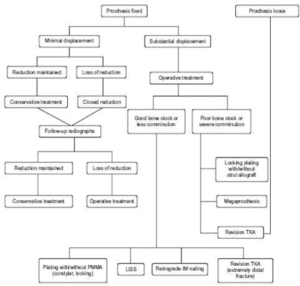
Figure 2: PPF flowchart.

Figure 3: Fixation plate.
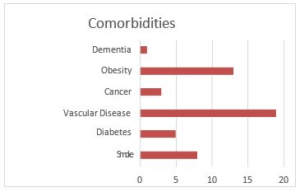
Figure 4: The graphic shows patients’ comorbidities.

Figure 5: Diagram showing types of fracture found in order to Rorabeck classification.

Figure 6: Variables considered in Sanders evaluation score.
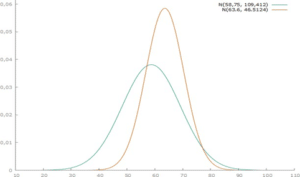
Figure 7: The graphic shows two curves refer to lyshome score values, the yellow curve refers to plate and screw treatment, instead the green line refers to IMN.

Figure 8: The graphic shows two curves refer to sanders score values, the green curve refers to plate and screw treatment, instead the yellow curve refers to IMN treatment.

Figure 9: The graph shows the distribution curves of average values. The green curve refers to the female scores of the Lysholm score, the yellow one to the male scores. The purple curve refers to the female scores of the Sanders score, the pink one to the male scores.

Figure 10: The graphic shows p-value = 0.2638 (>0,05). There is no difference between the two averages
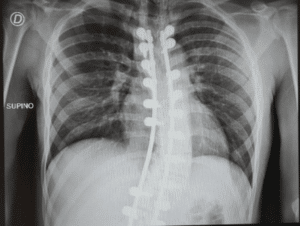
Figure 11: Rx imaging of vertebral arthrodesis, patient CG, male.

Figure 12: Rx imaging of left knee, there is a decomposed fracture grade II according to Rorabeck classification system. (A) A-P projection, (B) L-L projection.
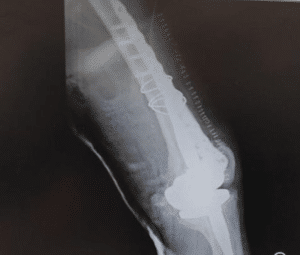
Figure 13: Rx imaging after surgery.

Figure 14: Rx imaging after 4 months from surgery.
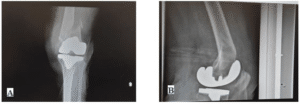
Figure 15: Rx imaging of the PPF of the right femur. (A) The A-P projection, (B) L-L projection.
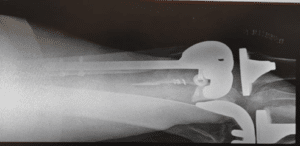
Figure 16: Rx imaging after IMN surgery.

Figure 17: Rx imaging after 4-month follow up shows nail’s mobilization. A-P projection.

Figure 18: L-L projection.

Table 1: Several type of knee prosthesis and compatibility with IMN.
Lysholm Score | Surgery Outcome |
<65 | Poor |
65-83 | Fair |
84-94 | Good |
95-100 | Excellent |
Table 2: Lysholm score in patients.
Sanders Functional Evaluation | Surgery Outcome |
0-15 | Poor |
16-25 | Fair |
26-35 | Good |
36-40 | Excellent |
Table 3: Sanders functional evaluation.
| Lyshom Score | Sanders Evaluation Score |
Mean ± SD | 63.60 ± 6,82 | 28.26 ± 6.01 |
Table 4: Mean results obtained from evaluation by Lysholm Score and the Sanders Functional Evaluation Score.
Lysholm Score | Sanders Evaluation Score | |
Mean ± SD | 58.75 ± 10.46 | 23.63 ± 6.61 |
Table 5: clinical results obtained with the retrograde intramedullary nail.
Lysholm Score | Sanders Evaluation Score | |
Mean ± SD Women (n=13) | 63.00 ± 7.17 | 28.54 ± 6.57 |
Mean ± SD Men (n = 10) | 58.22 ± 7.26 | 22.78 ± 3.83 |
Table 6: Scores as a function of gender.


